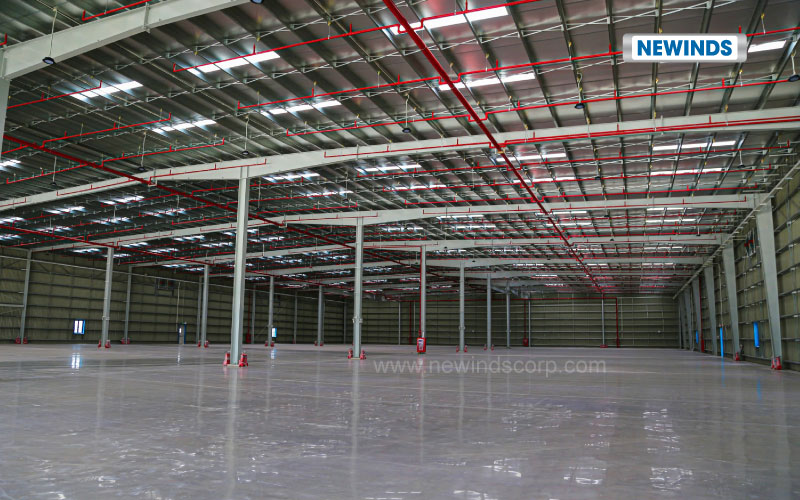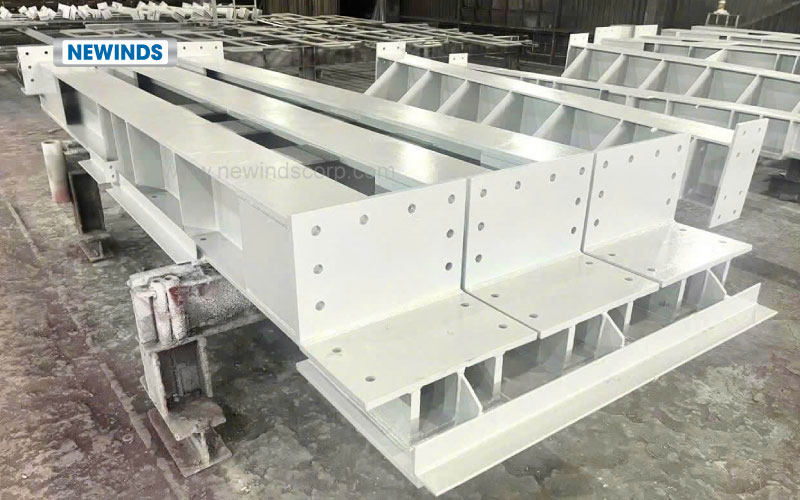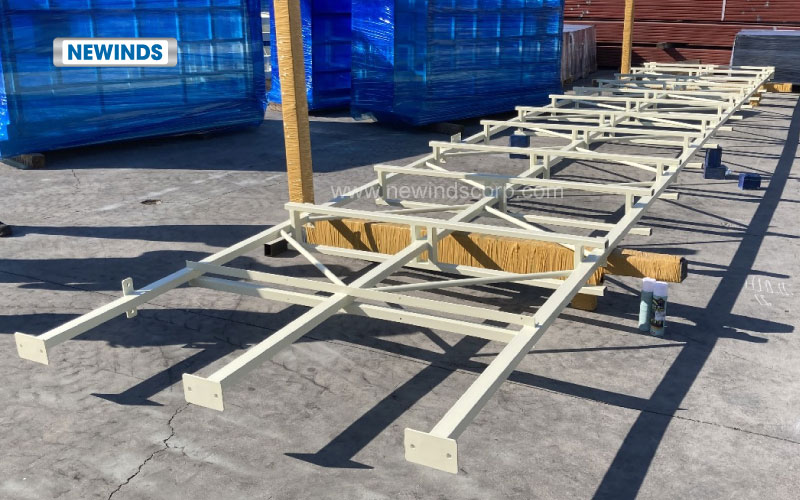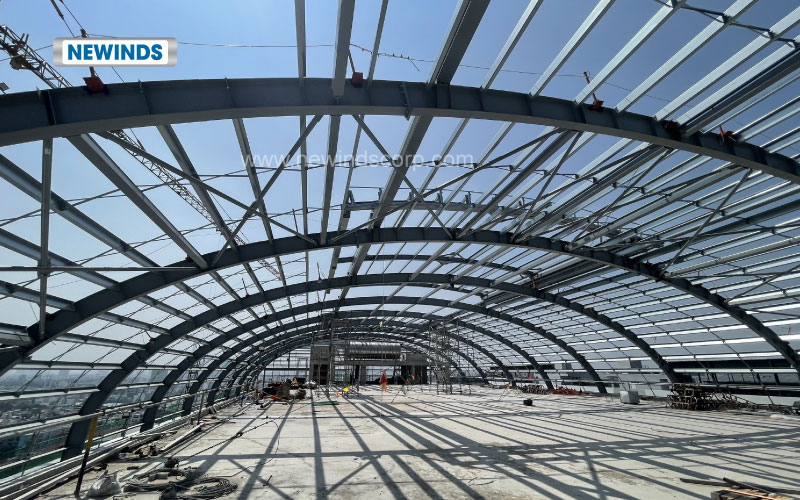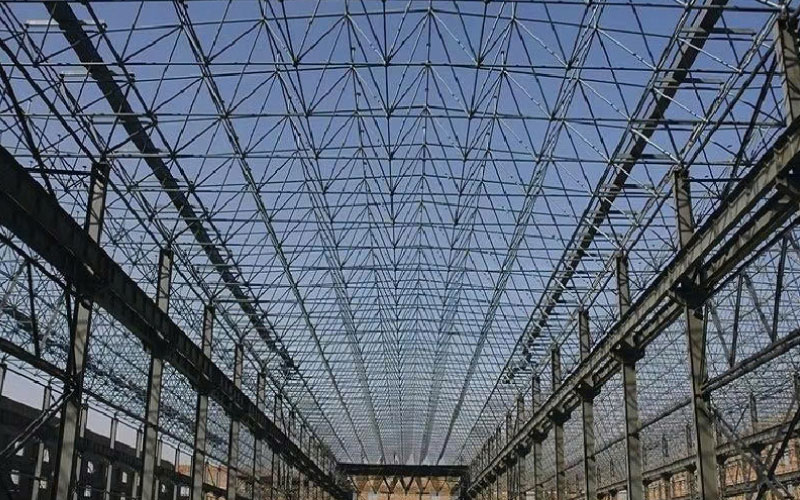According to Market.us, industrial steel buildings in the non-residential segment accounted for 60.5% of the global steel structure market share in 2023. This popularity stems from the high load-bearing capacity and durability of steel structures. So, what are the most common types of steel structures used in industrial steel buildings?
WHY CHOOSE STEEL FOR INDUSTRIAL BUILDINGS?
The preference for steel in industrial and commercial construction is driven by its mechanical properties. Steel offers a high strength-to-weight ratio, excellent tensile strength, superior corrosion resistance (when treated), and efficient recyclability, enabling quick adaptation to changing business needs. These qualities make steel buildings a top choice for durable and adaptable industrial projects.
-
Portal Frame Structures
These are the most common steel structures due to their simplicity and efficiency. They consist of vertical steel columns and horizontal beams connected by rigid joints, forming a stable frame capable of spanning large distances (up to 50-100 meters) without intermediate columns, optimizing interior space.
This advantage makes portal frame structures ideal for integrating overhead cranes or mezzanines in warehouses, factories, or distribution centers.
-
Beam and Column Frame Structures
Beam and column frame structures form the backbone of multi-story industrial steel buildings. This system uses horizontal beams supported by vertical columns, bolted or welded together to create a grid-like framework.
Structural steel beams offer high flexibility, making them ideal for multi-story facilities or storage centers with vertical stacking. However, this structural steel beam system often requires additional internal columns, which may limit available floor space.
-
Truss Structures
Designed based on triangulation principles, truss structures optimize strength while minimizing material use, focusing on axial forces (tension or compression) rather than bending or shear. They are an ideal solution for roofing large industrial steel buildings.
This system uses steel bars or tubes arranged in triangular units for optimal strength. Steel truss structures are suitable for roofs, bridges, or large spaces like aircraft hangars.
-
Arch Structures
Arch structures consist of:
– Main Arch: A curved component made from high-strength steel to withstand significant compressive forces without bending.
– Arch Supports: Support structures at both ends, often requiring deep foundations for stability.
– Auxiliary Systems: Including cross beams, roofing, and insulation for modular assembly.
The primary advantages of arch structures include creating large open spaces, efficient natural light integration, and flexibility for expansion or disassembly. However, their complex design makes them less suitable for lateral loads and limits vertical height.
-
Grid Structures
Grid structures comprise steel bars (tubes or profiles) connected at nodes to form a continuous lattice, typically in square, triangular, or hexagonal patterns. They function as a space frame or flat grid, distributing loads evenly in multiple directions.
In prefabricated steel buildings, grid structures are pre-manufactured as modular units, reducing construction time by 30-50%. This solution is highly effective for industrial steel buildings requiring rapid deployment.
FAQS ABOUT STEEL STRUCTURES
1.What is the average construction time for industrial steel buildings?
The construction time for industrial steel buildings depends on the project’s size, structure type, customization level, and additional features.
– For smaller projects (under 5,000 m²): 3-5 months from design to completion.
– For larger projects (10,000-20,000 m²): 5-8 months.
2. Are steel buildings more cost-effective than concrete buildings?
Steel buildings typically offer competitive initial and lifecycle costs compared to concrete buildings, with steel buildings prices varying based on factors such as design and scale. However, savings depend on the project type, scale, and specific requirements.
3. How often should prefabricated steel building projects be maintained?
– Regular inspections: Conduct every 1-2 years to check joints, anti-corrosion coatings (e.g., galvanization), and roof/wall conditions.
– Major maintenance: Every 5-10 years, repaint anti-corrosion coatings, inspect insulation, and repair worn components (e.g., doors, gutters).
4. How do I choose the right steel structure for my industrial project?
To select the appropriate steel structure for your industrial steel building, consider key factors such as project purpose, budget, timeline, site conditions, and long-term needs.
With the long-term growth potential of industrial steel buildings, they represent a sustainable and cost-effective investment for stakeholders. Selecting a reputable steel structure manufacturer is key to ensuring your steel building project achieves maximum efficiency and success.
If you are in search of a high-quality steel structure fabricator, delivered with expert consultation and industry knowledge, we welcome the opportunity to discuss your needs.
Contact Newinds today to discuss your requirements
Email: sales@newindscorp.com
Phone/Whatsapp: +84 868 482 038
